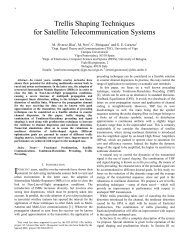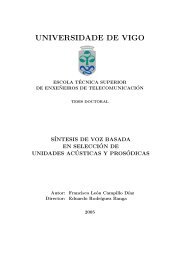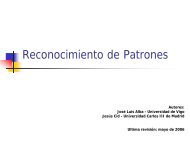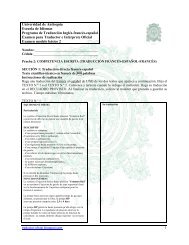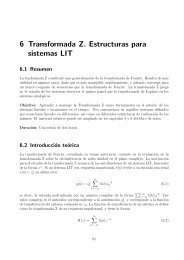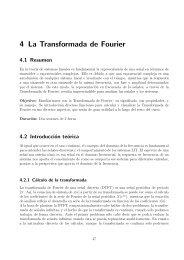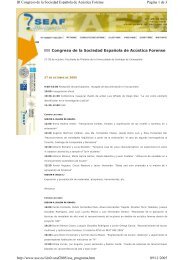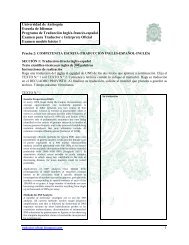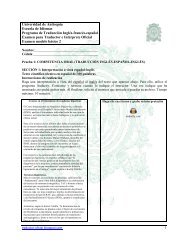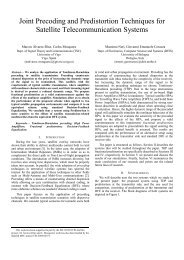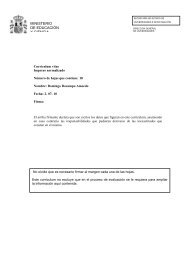A new method for perspective correction of document images
A new method for perspective correction of document images
A new method for perspective correction of document images
- No tags were found...
You also want an ePaper? Increase the reach of your titles
YUMPU automatically turns print PDFs into web optimized ePapers that Google loves.
A <strong>new</strong> <strong>method</strong> <strong>for</strong> <strong>perspective</strong> <strong>correction</strong> <strong>of</strong> <strong>document</strong> <strong>images</strong>José Rodríguez-Piñeiro a , Pedro Comesaña-Alfaro a,b , Fernando Pérez-González a,b,c and AlbertoMalvido-García da University <strong>of</strong> Vigo, Signal Theory and Communications Dept., Vigo, Spainb University <strong>of</strong> New Mexico, Electrical and Computer Engineering Dept., Albuquerque, NMc Gradiant (Galician Research and Development Center in Advanced Telecommunications),Vigo, Spaind Bit Oceans Research, López de Neira, 3, Office 408, 36202 Vigo, SpainABSTRACTIn this paper we propose a <strong>method</strong> <strong>for</strong> <strong>perspective</strong> distortion <strong>correction</strong> <strong>of</strong> rectangular <strong>document</strong>s. This schemeexploits the orthogonality <strong>of</strong> the <strong>document</strong> edges, allowing to recover the aspect ratio <strong>of</strong> the original <strong>document</strong>.The results obtained after correcting the <strong>perspective</strong> <strong>of</strong> several <strong>document</strong> <strong>images</strong> captured with a mobile phoneare compared with those achieved by digitizing the same <strong>document</strong>s with several scanner models.Keywords: Document image, <strong>perspective</strong> distortion <strong>correction</strong>1. INTRODUCTIONNowadays, the increasing per<strong>for</strong>mance and low price <strong>of</strong> portable imaging devices (e.g. mobile phones, PDAs) areboosting the usage <strong>of</strong> these devices <strong>for</strong> supplementing or even replacing traditional flat-bed scanners <strong>for</strong> <strong>document</strong>image adquisition. Un<strong>for</strong>tunately, a number <strong>of</strong> problems that traditional scanners do not have to face have arisenwith this increasing use, with <strong>perspective</strong> distortion one <strong>of</strong> the most evident and probably most harmful <strong>for</strong> thesubsequent application <strong>of</strong> <strong>document</strong> processing tools. Although this problem has already deserved some attentionin previous works in the literature, most <strong>of</strong> the proposed solutions are based on rather restrictive assumptionson the nature <strong>of</strong> the captured <strong>document</strong>, so the target <strong>of</strong> this work is to follow a systematic approach with aminimum number <strong>of</strong> constraints. Indeed, the only constraint imposed on our <strong>method</strong> is that the four corners <strong>of</strong>the <strong>document</strong> are captured in the considered image.Next, we review some <strong>of</strong> the most representative <strong>method</strong>s related to <strong>perspective</strong> distortion <strong>correction</strong>. These<strong>method</strong>s can be classified into two main categories. The <strong>method</strong>s in the first category use the text in the<strong>document</strong> <strong>for</strong> characterizing <strong>perspective</strong> distortion. The second category encompasses those algorithms that donot require that the original <strong>document</strong> includes text. A deeper discussion about both is provided below.1.1 Methods requiring text in the <strong>document</strong>Clark and Mirmehdi 1 proposed a <strong>perspective</strong> distortion <strong>correction</strong> <strong>method</strong> based on the use <strong>of</strong> vanishing pointsrecovery, where these points provide the in<strong>for</strong>mation required to correct the <strong>perspective</strong> distortion <strong>of</strong> the captured<strong>document</strong>. In this work, the recovery <strong>of</strong> the vanishing points is based on the assumption that a text paragraphmust display some sort <strong>of</strong> left, right, centered or full <strong>for</strong>matting. Probably, its main drawbacks are the computationalcost required by some steps <strong>of</strong> the <strong>correction</strong> <strong>method</strong> —including several image trans<strong>for</strong>mations andexhaustive searches on some parameters, such as the horizontal vanishing point— and the need <strong>of</strong> knowing somecorrespondences between imaged points and their real-world counterparts.A different approach is followed by Lu et al., 2 where a <strong>method</strong> based on applying morphological operators isproposed. This <strong>method</strong> needs neither high-contrast <strong>document</strong> boundaries nor paragraph <strong>for</strong>matting in<strong>for</strong>mation.Nevertheless, it is constrained to deal with text <strong>document</strong>s, and, even more importantly, it is based on the use<strong>of</strong> some parameters that require much knowledge about the <strong>document</strong> contents, like the number <strong>of</strong> charactersFurther author in<strong>for</strong>mation: (Send correspondence to P. C.-A.)P. C.-A.: E-mail: pcomesan@gts.uvigo.es, Telephone: +34 986818655
in the <strong>document</strong> image, and some parameters that are not automatically tuned, like some parameters used todiscard false detections <strong>of</strong> top and bottom lines <strong>of</strong> the text; thus, small changes on the value <strong>of</strong> those parameterscan make the <strong>method</strong> fail. More recently, Lu and Tan have presented an extended version <strong>of</strong> the mentionedwork, 3 although it inherits the discussed drawbacks.Morphological operations are also used in the <strong>method</strong> proposed by Miao and Peng, 4 although a smallerknowledge about the contents <strong>of</strong> the <strong>document</strong> is required in comparison with Lu et al.’s aproaches. Additionally,an adaptive thresholding technique is adopted to binarize the capture, which makes the <strong>method</strong> capable <strong>of</strong> dealingwith lighting variations. Nevertheless, no clue is provided on how to obtain the value <strong>of</strong> some parameters —likethe size <strong>of</strong> structure elements used to cluster the detected connected components into text lines—. Furthermore,the image <strong>correction</strong> process requires the use <strong>of</strong> three trans<strong>for</strong>mations, which are computationally expensive.Methods that do not depend so much on the contents <strong>of</strong> the <strong>document</strong>, as they are not exclusively aimed attext-based <strong>document</strong>s, are due to Yun. 5,6 The first <strong>of</strong> them is centered on the <strong>perspective</strong> estimation problem,while the second one is focused on the rectification system design. Indeed, Yin et al. 5 describe a <strong>method</strong> thatuses textual in<strong>for</strong>mation —if it is available— and also other sources <strong>of</strong> in<strong>for</strong>mation, such as <strong>document</strong> boundaries.Nevertheless, most <strong>of</strong> the <strong>method</strong> is based on the clues provided by textual in<strong>for</strong>mation. In this case there arealso some parameters that are not automatically tuned —like the thresholds used to classify a detected line ashorizontal—. On the other hand, both <strong>method</strong>s are carefully designed to minimize the computational cost. Infact, a multi-stage approach to <strong>perspective</strong> <strong>correction</strong> is proposed 6 which is able to avoid some unnecesary stages.Nevertheless, the most important drawback <strong>of</strong> these <strong>method</strong>s is the fact that they are not able to recover theoriginal aspect ratio <strong>of</strong> the <strong>document</strong>.Iwamura et al. 7 proposed a <strong>method</strong> that estimates the depth <strong>of</strong> each area <strong>of</strong> the <strong>document</strong> by using measurements<strong>of</strong> its textual contents, like the variation <strong>of</strong> the area <strong>of</strong> characters with respect to their position.Nevertheless, the proposed aproach does not obtain the focal length, being only able to recover an affine distortedversion <strong>of</strong> the original <strong>document</strong>.Finally, there exist some considerations that can make the <strong>method</strong>s based on text <strong>document</strong>s undesirable<strong>for</strong> general applications. First <strong>of</strong> all, it is obvious that the requirement <strong>of</strong> dealing with text <strong>document</strong>s reducesthe generality <strong>of</strong> the designed <strong>method</strong>s, and hence, the potential number <strong>of</strong> applications. In addition, most <strong>of</strong>the described <strong>method</strong>s constrain features like the size <strong>of</strong> the text, as well as its variation over the <strong>document</strong>, orparameters about the paragraphs <strong>for</strong>matting. Furthermore, according to the described algorithms, most <strong>of</strong> themcould fail when restoring handwritten <strong>document</strong>s, or those written with some particular typographies, such asitalics, where the tips <strong>of</strong> the characters are not vertical. Also, the presence <strong>of</strong> several columns <strong>of</strong> text can makesome <strong>method</strong>s fail, as well as the consideration <strong>of</strong> different alphabets —like some kinds <strong>of</strong> writing that are notordered from left to right and from top to bottom—. According to these facts, it is reasonable to pay attentionto those <strong>method</strong>s that do not require the presence <strong>of</strong> text in the <strong>document</strong>.1.2 Methods not requiring text in the <strong>document</strong>A more theoretic approach than those followed in the <strong>method</strong>s presented in the previous section is introducedby Liebowitz and Zisserman. 8 This approach is not only suitable <strong>for</strong> recovering the fronto-parallel view <strong>of</strong> text<strong>document</strong>s, but also <strong>for</strong> describing the geometry, constraints and algorithmic implementations that allow metricproperties <strong>of</strong> figures on a plane, like angles and length ratios, to be measured from a captured image <strong>of</strong> that plane.Perhaps the most novel contribution <strong>of</strong> this work is the presentation <strong>of</strong> different ways <strong>of</strong> providing geometricalconstraints, including the availability <strong>of</strong> a known angle in the original scene, two equal but unknown angles, or aknown length ratio. Un<strong>for</strong>tunately, <strong>for</strong>mal pro<strong>of</strong>s supporting those procedures are not provided. It must be alsonoted that, depending on the level <strong>of</strong> knowdelegde about the contents <strong>of</strong> the <strong>document</strong> —measured by means <strong>of</strong>the number <strong>of</strong> known pairs <strong>of</strong> orthogonal lines in the original scene—, more than a single image trans<strong>for</strong>mationmay be required.On the other hand, there also exist a great number <strong>of</strong> publications that deal with camera calibration. Althoughthey are not designed <strong>for</strong> per<strong>for</strong>ming <strong>perspective</strong> distortion <strong>correction</strong> <strong>of</strong> captures, they can be used to estimatethe camera position and its orientation in relation to the imaged <strong>document</strong>. Un<strong>for</strong>tunately, since those <strong>method</strong>shave been designed <strong>for</strong> other purposes, most <strong>of</strong> them cannot be applied to the <strong>perspective</strong> distortion <strong>correction</strong>problem.
This is not the case <strong>of</strong> Guillou et al.’s approach, 9 where a <strong>method</strong> is proposed <strong>for</strong> camera calibration as wellas recovering fronto-parallel views <strong>of</strong> general three-dimensional scenes. Although the followed approach is similarto that described in the current work, especially in what concerns the characterization <strong>of</strong> the camera parameters,the estimation <strong>of</strong> the camera position and orientation in Guillou et al.’s approach is based on the use <strong>of</strong> twovanishing points, being the trans<strong>for</strong>mation per<strong>for</strong>med by using projective coordinates. In contrast, our approachis exclusively based on Euclidean geometry, not requiring the use <strong>of</strong> vanishing points nor projective coordinates.In any case, it is interesting to remark that the limitations and requirements <strong>of</strong> both <strong>method</strong>s are very similar.T. M. Breuel and colleagues have also published several works dealing with the rectification <strong>of</strong> <strong>document</strong><strong>images</strong>. Of those works, the most similar one 10 to the current proposal is based on the work by Zhang and He. 11Special attention should be devoted to the latter paper, where the authors propose a <strong>method</strong> that enhanceswhiteboards captures. Indeed, the approach followed by those authors to estimate the focal distance and theaspect ratio <strong>of</strong> the original object (a rectangular whiteboard) is similar to that presented here, although thespecific way <strong>of</strong> per<strong>for</strong>ming picture points trans<strong>for</strong>mation is not specified (which is instead done in the currentpaper). Furthermore, the current work studies in detail the problematic cases, i.e. those situations where the<strong>perspective</strong> distortion parameters can not be estimated. As it happened <strong>for</strong> Guillou et al.’s approach, 9 both therequirements and the limitations <strong>of</strong> Zhang and He’s proposal 11 are similar to those <strong>of</strong> the <strong>method</strong> introducedbelow.The remainder <strong>of</strong> this paper is organized as follows: Sect. 2 introduces the considered capture process model,and the proposed <strong>perspective</strong> distortion <strong>correction</strong> <strong>method</strong> is introduced in Sect. 3. Experimental results areprovided in Sect. 4, and Sect. 5 presents the main conclusions.2. CAPTURE PROCESS MODELWhen a three-dimensional scene is photographed, a two-dimensional image is captured. Although this dimensionalityreduction inherently entails ambiguity about the photographed scene, in this work it will be shown thatwhenever some constraints about the photographed object are met, a good estimate <strong>of</strong> the original object canbe obtained (although modified by an isotropic-scaling). Specifically, a <strong>method</strong> is proposed aimed at estimatingthe original <strong>document</strong>-plane relative coordinates <strong>of</strong> a rectangular <strong>document</strong>.In order to achieve this goal, in this section the capture model <strong>of</strong> a flat <strong>document</strong> will be given, and in thenext section the possibility <strong>of</strong> obtaining the inverse trans<strong>for</strong>m <strong>of</strong> that capture process will be studied.Three different coordinate systems will be introduced to illustrate the capture process <strong>of</strong> a flat <strong>document</strong>:• Original <strong>document</strong> plane. Let us denote by ¯x the coordinates <strong>of</strong> a point <strong>of</strong> the original <strong>document</strong> inthe plane defined by that <strong>document</strong>, so ¯x ∈ R 2 . The origin <strong>of</strong> this two-dimensional space will be assumedto be located at a corner <strong>of</strong> the <strong>document</strong>, and its axes will be aligned with <strong>document</strong> edges.• Three-dimensional space. Given that the <strong>document</strong> to be photographed is located in a three-dimensionalspace, ¯x will be trans<strong>for</strong>med onto a different point ȳ ∈ R 3 . The origin <strong>of</strong> this three-dimensional space willbe located at the camera center.• Image plane. When the <strong>document</strong> located in a three-dimensional space is captured, a two-dimensionalimage is obtained. This process needs to define an aiming direction in R 3 , and a plane orthogonal to thatdirection, i.e. the so-called image plane. Consequently, ȳ will produce a point in the two-dimensional imageby intersecting the straight line defined by ȳ and the camera center with the image plane; this intersectingpoint will be denoted by ¯z ∈ R 3 . For the sake <strong>of</strong> simplicity, the aiming direction will coincide with thethird component <strong>of</strong> the three-dimensional space introduced above, so the points on the image plane will becharacterized by sharing their third component, i.e. ¯z = (¯z 1 , ¯z 2 , ¯f) T , where ¯f is usually named camera’sfocal length. Finally, the origin <strong>of</strong> this image plane, i.e. (0,0, ¯f) T , will be located at the center <strong>of</strong> theobtained rectangular image.This notation, used <strong>for</strong> denoting the point coordinates according to the different coordinate systems, shouldnot be confused with that followed <strong>for</strong> referring to the coordinate system components; namely, X, Y and Z
Figure 1. Pinhole model.will be used <strong>for</strong> denoting the first, second, and (where applicable) third component <strong>of</strong> the considered coordinatesystem.The used capture model is depicted in Fig. 1, and it is usually named pinhole model <strong>of</strong> the camera, 12 beingextensively used in the literature.Taking into account the definition <strong>of</strong> ¯z and ȳ, it is straight<strong>for</strong>ward to see that there exists a scalar ¯λ > 0 suchthat ȳ = ¯λ¯z, and at the same time all the values <strong>of</strong> y equal to λ¯z <strong>for</strong> any λ > 0 will produce the same capturedpoint, showing the capture ambiguity mentioned at the beginning <strong>of</strong> this section. An example <strong>of</strong> this ambiguityis illustrated in Fig. 1, where both ȳ and y would produce the same captured point ¯z. Finally, it will be usefulto take into account that ¯λ can be constrained to be strictly positive, as ȳ cannot be the null vector (i.e., we willassume that the <strong>document</strong> will not be located at the camera center).The approach followed in this work <strong>for</strong> correcting the <strong>perspective</strong> distortion is based on per<strong>for</strong>ming the inverseoperations to those involved in the capture process.3. INVERTING THE CAPTURE PROCESS3.1 Recovering the three-dimensional coordinates <strong>of</strong> the cornersLet ¯z i be the image plane coordinates <strong>of</strong> the ith corner <strong>of</strong> the <strong>document</strong>, where i = 0, · · · ,3, and the indices areassigned in such a way that the ith corner’s neighbors are the (i ± 1)mod4-th corners. Following the notationintroduced in the previous section, the first two components <strong>of</strong> ¯z i determine the position <strong>of</strong> the ith corner <strong>of</strong>the <strong>document</strong> in the captured image. Nevertheless, the value <strong>of</strong> the third component, i.e. ¯f, will be usually notknown at the image processing side. There<strong>for</strong>e, in order to invert the capture process, we will assume that thevalue <strong>of</strong> that parameter is f, and afterwards, as it will be shown below, the value <strong>of</strong> f will be estimated takinginto account the geometrical properties <strong>of</strong> the original <strong>document</strong>. Consequently, we will denote by z i (¯z i 1, ¯z i 2,f)the estimated coordinates <strong>of</strong> the <strong>document</strong> on the image plane.According to the discussion presented above, one can compute the coordinates <strong>of</strong> every point in the threedimensionalspace yielding z i , obtaining the points in the straight semi-line y = λz i , with λ > 0. However, oneneeds to estimate the particular λ i ’s yielding y i = λ i z i , using again the geometrical properties among the y i ’s.
In order to achieve this target, we will assume, without loss <strong>of</strong> generality (as we allow an isotropical scaling),that λ 0 = 1, so y 0 = z 0 . Taking into account that the opposite edges <strong>of</strong> the <strong>document</strong> are parallel, it isstraightfoward to see that y 1 − y 0 = y 2 − y 3 , so z 0 = λ 1 z 1 − λ 2 z 2 + λ 3 z 3 , or in its matrix <strong>for</strong>m⎛⎝z 1 1 −z 2 1 z 3 1z 1 2 −z 2 2 z 3 2f −f f⎞ ⎛⎠ ⎝⎞λ 1λ 2⎠ = z 0 . (1)λ 3This system will have a unique solution whenever the matrix above has a non-null determinant, that will beindeed the case as long as we can not write z 3 as⎛ ⎞ ⎛ ⎞ ⎛ ⎞z11 zτ 1⎝ z21 12 z⎠ + τ 2⎝ z22 13⎠ = ⎝ z 3 ⎠2 ,f f <strong>for</strong> equivalently,τ 1(z11z 1 2)+ τ 2(z21z 2 2)=(z31z 3 2and τ 1 +τ 2 = 1, meaning that the captured image <strong>of</strong> the third vertex belongs to the straight line joining the firstand second vertices <strong>of</strong> the captured <strong>images</strong>. This case happens whenever one takes the picture <strong>of</strong> the <strong>document</strong>sideways, preventing its contents from being recovered.On the other hand, by taking into account that two adjacent edges <strong>of</strong> the original <strong>document</strong> are orthogonal,one can derive that (y 0 − y 3 ) T · (y 1 − y 0 ) = (z 0 − λ 3 z 3 ) T · (λ 1 z 1 − z 0 ) = 0, so[ ( z01z 0 2)− λ 3( z31z 3 2) ] T [ ( z0· 1z20)− λ 1( z11z 1 2enabling to compute the focal length, f, as the positive square root <strong>of</strong>−[ ( z01z 0 2) ( ) ] z3 T [ (− λ 1 z03z23 · 1z20(1 − λ 3 ) (1 − λ 1 )),) ]= −f 2 (1 − λ 3 ) (1 − λ 1 ) ,)− λ 1( z11z 1 2Problems would arise when computing the square root whenever the <strong>for</strong>mer term were negative, or its denominatorwere null. The first case is not possible due to the geometrical properties <strong>of</strong> the considered kind <strong>of</strong><strong>document</strong>s, so we will focus on the second one, which will require that either λ 1 = 1, or λ 3 = 1, or both <strong>of</strong> themsimultaneously, meaning that the focal length will be undetermined or infinite.Considering λ 1 = 1, and taking into account that the product <strong>of</strong> the last row <strong>of</strong> the matrix in (1) by the vector(λ 1 ,λ 2 ,λ 3 ) T implies that λ 1 − λ 2 + λ 3 = 1, it is clear that in that case λ 2 = λ 3 , so y 2 and y 3 will be located atthe same distance from the image plane. Furthemore, z 1 − z 0 = λ 2 (z 2 − z 3 ), meaning that the edges that jointhe points z 0 and z 1 as well as z 3 and z 2 are also parallel in the captured image. Although the constraint onthe rectangular nature <strong>of</strong> the <strong>document</strong>, summarized by (1), is verified <strong>for</strong> any value <strong>of</strong> f, the ratio between thelengths <strong>of</strong> the orthogonal edges depends on that parameter, as it is defined as√r ||z0 − z 1 ||||z 0 − λ 3 z 3 || =(z1 0 − z1 1 )2 + (z1 0 − z1 2√(z )2,1 0 − λ 3z1 3)2 + (z1 0 − λ 3z2 3)2 + f 2 (1 − λ 3 ) 2showing that in this particular case the ratio between edges can not be recovered. A similar reasoning can beapplied to the case λ 3 = 1.On the other hand, if both λ 1 = 1 and λ 3 = 1, then, from the constraint provided by the last row <strong>of</strong> (1), it isstraight<strong>for</strong>ward to see that λ 2 = 1, so in that case the four vertices <strong>of</strong> the original <strong>document</strong> belong to the planez i 3, i.e. the captured <strong>document</strong> has no <strong>perspective</strong> distortion.) ].
Summarizing, although when both λ 1 and λ 2 are equal to 1 the irrecoverability <strong>of</strong> the focal length is notrelevant, as there is no <strong>perspective</strong> distortion to be corrected, this is indeed a problem when only one <strong>of</strong> them isequal to 1. Note that, although Zhang and He 11 only consider explicitly the case where both λ 1 and λ 2 are equalto 1, it can be easily proved that their approach also fails to recover the aspect ratio when only one <strong>of</strong> them isequal to 1.3.2 Recovering the three-dimensional coordinates <strong>of</strong> an arbitrary <strong>document</strong> pointOnce the three-dimensional coordinates <strong>of</strong> the four <strong>document</strong> corners have been recovered (except <strong>for</strong> an isotropicalscaling), one can use that in<strong>for</strong>mation to calculate the three-dimensional coordinates y <strong>of</strong> an arbitrary pointon the captured <strong>document</strong> ( ¯z 1 , ¯z 2 ). Obviously, the derivation <strong>of</strong> y requires to calculate the value <strong>of</strong> λ such thaty = λz lies on the plane defined by y i , i = 0, · · · ,3. It can be seen that the value <strong>of</strong> λ we are looking <strong>for</strong> is givenby 13∣λ = −∣1 1 1 1y 0 1 y 1 1 y 2 1 0y 0 2 y 1 2 y 2 2 0y 0 3 y 1 3 y 2 3 0∣∣1 1 1 0 ∣∣∣∣∣∣∣. (2)y1 0 y1 1 y1 2 z 1y2 0 y2 1 y2 2 z 2y3 0 y3 1 y3 2 z 3One should be especially careful when the denominator <strong>of</strong> the last expression is null, an event that willhappen if and only if the columns <strong>of</strong> the matrix considered in the denominator <strong>of</strong> (2) are linearly dependent. Forthe sake <strong>of</strong> simplicity, we will partition all the possible scenarios where this condition is verified in two subsets:1) one can find τ 0 and τ 1 such that τ 0 y 0 + τ 1 y 1 = y 2 , with τ 0 + τ 1 = 1, (i.e. the first three columns <strong>of</strong> thementioned matrix are linearly dependent) and 2) the first three columns <strong>of</strong> the matrix are linearly independent,but τ 0 y 0 + τ 1 y 1 + τ 2 y 2 = z and τ 0 + τ 1 + τ 2 = 0.Although in the first case the numerator <strong>of</strong> (2) will be also null, which would produce an undetermined result,one can see that the considered scenario violates the geometrical assumptions about the <strong>document</strong>, as it shouldhold τ 0 y 0 + (1 − τ 0 )y 1 = y 1 + τ 0 (y 0 − y 1 ) = y 2 , meaning that y 0 , y 1 and y 2 all lie on a straight line.On the other hand, in the second case the numerator <strong>of</strong> (2) will be non-null, so if the four columns <strong>of</strong> theconsidered matrix are linearly dependent, the λ corresponding to z would be infinite. Nevertheless, this wouldhappen if and only if−(τ 1 + τ 2 )y 0 + τ 1 y 1 + τ 2 y 2 = τ 1 (y 1 − y 0 ) + τ 2 (y 2 − y 0 ) = z, (3)i.e., z belongs to the plane containing the coordinate system origin (in this case, the camera center) and the points(y 1 − y 0 ) and (y 2 − y 0 ). Taking into account that the plane defined by the <strong>document</strong> in the three-dimensionalspace is given byy = y 0 + τ ′ 1(y 1 − y 0 ) + τ ′ 2(y 2 − y 0 ), (4)as y 0 , y 1 and y 2 can be described through (4), it is evident that the planes defined by (3) and (4) will be parallelor coincident. By definition, <strong>for</strong> each point <strong>of</strong> the <strong>document</strong> in the three-dimensional space y, there exists ascalar λ such that y = λz <strong>for</strong> some point <strong>of</strong> the image plane z. Thus, if z verifies (3), being y a scaled version <strong>of</strong>z, y will also verify (3). Nevertheless, since y belongs to the <strong>document</strong> plane in the three-dimensional space, itwill simultaneously verify (4), implying that y belongs to both planes, which would indeed coincide. There<strong>for</strong>e,(3) will be verified if and only if the origin <strong>of</strong> the three-dimensional coordinate system, i.e. the camera center,belongs to the plane defined by the <strong>document</strong>, meaning that the picture is taken sideways.In the non-degenerate cases where the denominator <strong>of</strong> (2) is non-null, one can writey =az, (5)bz 1 + cz 2 + df
where a ∣y1 0 y1 1 y12y2 0 y2 1 y22y3 0 y3 1 y32∣ ∣∣∣∣∣ 1 1 1∣ ,b y2 0 y2 1 y22y3 0 y3 1 y32∣ ∣∣∣∣∣ 1 1 1∣ ,c − y1 0 y1 1 y12y3 0 y3 1 y32∣ ∣∣∣∣∣ 1 1 1∣ , and d y1 0 y1 1 y12y2 0 y2 1 y22∣ .3.3 Recovering the coordinates <strong>of</strong> the corners on the original <strong>document</strong> planeAs it was mentioned in Sect. 2, the origin <strong>of</strong> the coordinates system <strong>of</strong> the original <strong>document</strong> plane will belocated at a corner <strong>of</strong> the <strong>document</strong>, that we will choose, without loss <strong>of</strong> generality, to be x 0 , where x denotesthe estimate <strong>of</strong> ¯x, and its axes will be aligned with the <strong>document</strong> edges. There<strong>for</strong>e, in order to estimate theoriginal <strong>document</strong> plane coordinates x, we will move the origin <strong>of</strong> the three-dimensional coordinates systemdescribing y and then rotate the <strong>new</strong> coordinates system until achieving a system such that x 0 = 0, and the<strong>document</strong> edges are aligned with the X and Y axes. Mathematically, we will denote by u i the translated version<strong>of</strong> y i , so D −y 0 · (y i ,1 ) T (= ui1 ,u i 2,u i 3,1 ) T, whereD −y 0 ⎛⎜⎝1 0 0 −y 0 10 1 0 −y 0 20 0 1 −y 0 30 0 0 1Then, we will compute three rotation matrices, namely R X (α), R Y (β) and R Z (γ), around the axes X, Yand Z, according to the angles α, β and γ, such that they translate the points u i onto the XY plane, and withthe edges <strong>of</strong> the <strong>document</strong> aligned with the Cartesian axes. These matrices are defined as⎛R X (α) = ⎝1 0 00 cos α sinα0 −sin α cos α⎞⎛⎠ ,R Y (β) = ⎝cos β 0 −sin β0 1 0sin β 0 cos β⎞⎟⎠ .⎞⎛⎠ , andR Z (γ) = ⎝cos γ sin γ 0−sin γ cos γ 00 0 1The first rotation matrix to be used will be R Z (γ). We will denote the point coordinates in the <strong>new</strong> coordinatesystem by v, so v i = R Z (γ)u i . Then, R Z (γ) will ( be calculated so that the rotated version <strong>of</strong> u 1 , i.e. v 1 , verifiesv 1 2 = 0. There<strong>for</strong>e, γ will be given by γ = arcsinu 1 2 q(u11 ) 2 +(u 1 2) 2 ), which is always properly defined, except whenu 1 1 = u 1 2 = 0; ∗ nevertheless, in that case the original point u 1 already lies on the plane u 1 2 = 0, so the soughttrans<strong>for</strong>mation is not required, and γ = 0.The next rotation we look <strong>for</strong> is R Y (β). The point coordinates in the <strong>new</strong> coordinate system will be denotedby w, so w i = ( R Y (β)v i . In this case, R Y (β) will be derived in order to yield w3 1 = 0, so β will be computed asβ = −arcsinv 1 3 q(v11 ) 2 +(v 1 3) 2 ), which is also properly defined, except <strong>for</strong> the case v 1 1 = v 1 3 = 0; as it happenedwhen defining γ, in this degenerate case this rotation is not necessary, so β = 0.The last rotation, R X (α), will ( translate the rotated version <strong>of</strong> w 3 to the XY plane. This implies that αwill be computed as α = arcsinw 3 3 q(w32 ) 2 +(w 3 3) 2 ), where, as it happened in the two previous cases, the angle isproperly defined as long as w 3 2 = w 3 3 = 0 is not met; if that condition were indeed verified, then this last rotationwould not be required, and α = 0.3.4 Recovering the original <strong>document</strong> plane coordinates <strong>of</strong> an arbitrary <strong>document</strong> pointUp to this point, we have only operated over the corners <strong>of</strong> the <strong>document</strong>. Nevertheless it is possible to generalizethe obtained results to any point belonging to the possibly isotropically scaled version <strong>of</strong> the <strong>document</strong>. Indeed,by definingG (RX (α) R Y (β) R Z (γ) 00 T 1)· D −y0 ,∗ Throughout this paper we will assume that arcsin(·) ∈ [−π/2, π/2], and consequently the related cos(·) will benon-negative.⎞⎠ .
if y belongs to the three-dimensional representation <strong>of</strong> the <strong>document</strong>, due to the geometrical properties <strong>of</strong> theproblem and those <strong>of</strong> the translation and rotation matrices defined above, it is straight<strong>for</strong>ward to see thatG · (y,1) T = (x 1 ,x 2 ,0,1) T . (6)This last equation, jointly with (2), establish a relationship between any point z on the captured image and thecorresponding point on the original <strong>document</strong> plane x. Nevertheless, due to the particular structure <strong>of</strong> matrixG, we show next that the computational cost <strong>of</strong> the inverse trans<strong>for</strong>mation can be reduced. In order to do so,we define(E G −1 RZ (−γ) R= D y 0 ·Y (−β) R X (−α) 00 T 1where G is non-singular, as |G| = 1. Taking into account that the third component <strong>of</strong> the rightmost term <strong>of</strong> (6)is null, one can write ⎛ ⎞ ⎛⎞ ⎛ ⎞z 1 e 11 e 12 e 14 x 1λ ⎝ z 2⎠ = ⎝ e 21 e 22 e 24⎠ ⎝ x 2⎠ ,z 3 e 31 e 32 e 34 1so defining⎛E R ⎝⎞e 11 e 12 e 14e 21 e 22 e 24⎠ ,e 31 e 32 e 34the original plane coordinates <strong>of</strong> an arbitrary <strong>document</strong> point will verify(x 1 ,x 2 ,1) T = λE −1R (z 1,z 2 ,z 3 ) T , (7)as long as E R is non-singular. For studying the invertibility <strong>of</strong> E R , its determinant is calculated, yieldingη |E R | = ( z 0 1 sin(γ) − z 0 2 cos (γ) ) sin (α) + [ z 0 3 cos (β) + ( z 0 1 cos (γ) + z 0 2 sin (γ) ) sin (β) ] cos (α) .Hence, definings i R X (α)R Y (β)R Z (γ)y i , (8)<strong>for</strong> i = 0, · · · ,3, it is easy to see that η = s 0 3, so E R will be non-singular if and only if the non-translated butrotated version <strong>of</strong> y 0 has a non-null third component. In order to see in which scenarios this condition is verified,we will take into account that x i = s i − R X (α) R Y (β) R Z (γ)y 0 , where i = 0, · · · ,3, so it is easy to concludethat both versions <strong>of</strong> the corners <strong>of</strong> the <strong>document</strong> (x i and s i ), will hold the same geometrical relationshipsbetween them. Specifically, the s i ’s are the vertices <strong>of</strong> a shifted version <strong>of</strong> the recovered <strong>document</strong>, so theydefine a plane. Furthermore, since α, β and γ were chosen to produce x i ’s verifiying x i 3 = 0, we have thatη = s 0 3 = s 1 3 = s 2 3 = s 3 3. There<strong>for</strong>e, given that the rotations defined by (8) do not modify the geometricalstructure <strong>of</strong> the problem described by the y coordinates system, the above equation implies that E R will benon-invertible just when the camera center and the four corners <strong>of</strong> the three-dimensional representation <strong>of</strong> the<strong>document</strong> y i are coplanar, i.e. when one takes the picture <strong>of</strong> the <strong>document</strong> sideways.Assuming that the degenerate case explained above is not verified, so η ≠ 0, and taking into account thatz 3 = f, (7) yields( ) [(x1 (E−1= λR ) 11 (E −1R ) ) ( ) (12 z1 (E−1x 2 (E −1R ) 21 (E −1R ) + fR ) )]1322 z 2 (E −1R ) ,23with (E −1R ) ij the (i,j) element <strong>of</strong> E −1R, so a simple relationship between z and x is obtained. The requiredelements <strong>of</strong> (E R ) −1 can be computed using the following <strong>for</strong>mulas(E −1R ) 11 = 1 [z0η 3 cos (α) cos (γ) + ( z3 0 sin (β) sin(γ) − z2 0 cos (β) ) sin (α) ] ,(E −1R ) 12 = 1 [z0η 1 cos (β) sin (α) − z3 0 cos (γ) sin (α) sin(β) + z3 0 cos (α) sin (γ) ] ,(E −1R ) 13 = 1 [(z0η 2 cos (γ) − z1 0 sin(γ) ) sin(α) sin (β) − ( z1 0 cos (γ) + z2 0 sin(γ) ) cos (α) ] ,),
(E −1R ) 21 = 1 [z0η 2 sin(β) + z3 0 cos (β) sin (γ) ] ,(E −1R ) 22 = 1 [z0η 3 cos (β) cos (γ) + z1 0 sin (β) ] , and(E −1R ) 23 = 1 [(z0η 1 sin (γ) − z2 0 cos (γ) ) cos (β) ] .3.5 Computational costOnce the proposed <strong>perspective</strong> distortion <strong>correction</strong> <strong>method</strong> has been introduced, its computational cost willbe discussed. For the sake <strong>of</strong> comparison we will consider the scheme by Guillou et al., 9 discused in Sect. 1.This <strong>method</strong> provides exactly the same results that the algorithm proposed in this paper, although followinga different approach. The number <strong>of</strong> operations required <strong>for</strong> per<strong>for</strong>ming the <strong>perspective</strong> distortion <strong>correction</strong>with both <strong>method</strong>s can be found in Table 1. One can see that both <strong>method</strong>s have a similar computationalcost; specifically, in view <strong>of</strong> those results, our <strong>method</strong> requires the evaluation <strong>of</strong> two more square roots than theGuillou et al.’s approach 9 <strong>for</strong> those terms that are computed once, but the number <strong>of</strong> sums, multiplications anddivisions is reduced by 45, 49 and 8, respectively, using our proposed <strong>method</strong>. Finally, it must be emphasizedthat the number <strong>of</strong> operations required <strong>for</strong> per<strong>for</strong>ming the distortion <strong>correction</strong> <strong>of</strong> each single pixel is the same<strong>for</strong> both cases.Table 1. Required number <strong>of</strong> operations <strong>for</strong> each considered implementation (S = Number <strong>of</strong> sums/substractions, P =Number <strong>of</strong> multiplications, C = Number <strong>of</strong> divisions, R = Number <strong>of</strong> square roots).MethodOps. per<strong>for</strong>med once Ops. per pixelS P C R S P C RCurrent approach 66 91 7 7 6 8 1 0Guillou et al.’s approach 9 111 140 15 5 6 8 1 04. EXPERIMENTAL RESULTSAs it was discussed in Sect. 1, most <strong>of</strong> existing <strong>perspective</strong> distortion <strong>correction</strong> <strong>method</strong>s are not applicable tothe scenario considered in this paper. There<strong>for</strong>e, taking into account that the target <strong>of</strong> the proposed <strong>method</strong>is to provide a functionality as similar as possible to that <strong>of</strong> a scanner, <strong>for</strong> comparison purposes we will checkthe results obtained by the <strong>method</strong> introduced in this work with those obtained by several scanner models.Nevertheless, a lot <strong>of</strong> nuisance factors, that is, those that are not directly related to the <strong>perspective</strong> distortion<strong>correction</strong> but are generally due to the quality <strong>of</strong> the capture device, are involved in the quality <strong>of</strong> the recovered<strong>document</strong> (e.g. non-uni<strong>for</strong>m lighting, blur effect, resolution, etc.). Given that the scanners are expected tobe clearly superior to mobile device cameras with respect to those factors, the feature chosen <strong>for</strong> comparingthe results <strong>of</strong> the proposed scheme with the captures obtained by the considered scanners should desirably beindependent <strong>of</strong> those nuisance factors. An example <strong>of</strong> such a feature, which will be used in the remainder <strong>of</strong> thiswork, is the the aspect ratio <strong>of</strong> the recovered <strong>document</strong> r, which is here taken to be always greater or equal than1, i.e., r = max(r 0 ,1/r 0 ), where∣ ∣ x 1 − x 0∣ ∣ ∣ ∣∣ + ∣x 3 − x 2∣ ∣ ∣ r 0 ||x 0 − x 3 || + ||x 2 − x 1 || .It is also worth pointing out that we are assuming that a priori in<strong>for</strong>mation about the aspect ratio <strong>of</strong> the original<strong>document</strong> is not available neither <strong>for</strong> the scanners nor <strong>for</strong> the proposed scheme, providing a realistic framework.4.1 Experimental Framework• Document <strong>for</strong>mats: Four different blank <strong>document</strong>s were considered in the developed tests, with respectivesizes 216×279 mm (Letter, r = 31/24), 210×297 mm (DIN-A4, r = √ 2), 148×210 mm (DIN-A5, r = √ 2),and 100 × 100 mm (r = 1).
• Mobile capture device: The <strong>document</strong> photos were taken with a 5 megapixels camera, corresponding to aNokia N82 mobile phone, being the corners <strong>of</strong> the captured <strong>document</strong> located by using a <strong>method</strong> proposedby us elsewhere. 14 The results reported in this section <strong>for</strong> the <strong>method</strong> proposed in this work were obtainedusing 6 letter-sized, 19 DIN-A4, 14 DIN-A5, and 14 100×100 mm <strong>document</strong> photos, captured with differentcamera locations and orientations.• Scanners: The considered <strong>document</strong>s were also captured using seven different scanners: the automatic<strong>document</strong> feeding scanner Fujistu Fi-5210c, and the flat-bed scanners with manual <strong>document</strong> feeding CanonMP-550, EPSON Perfection 1200 Photo, EPSON Stylus SX-105, HP ScanJet 4470C and HP ScanJet 5100C.All <strong>of</strong> them were fed with all the considered blank <strong>document</strong>s. In order to evaluate both the mean valueand the variability <strong>of</strong> the obtained results, each <strong>document</strong> was scanned 5 times, changing the position <strong>of</strong>the <strong>document</strong> <strong>for</strong> each scan.Given that the distortion <strong>perspective</strong> <strong>correction</strong> <strong>method</strong> proposed in this work estimates the coordinates <strong>of</strong>the <strong>document</strong> corners, the derivation <strong>of</strong> the aspect ratio obtained when applying that <strong>method</strong> is straight<strong>for</strong>ward.This is no longer the case when we consider scanned <strong>document</strong>s, so we will introduce here the <strong>method</strong> followedto estimate the <strong>document</strong> corners in that scenario. First <strong>of</strong> all, in order to avoid undesiderable shadows in thecapture, all the <strong>document</strong>s digitized with the flat-bed scanners were scanned over a black background. Secondly,given that the scanned <strong>document</strong>s are blank, Otsu’s <strong>method</strong> 15 can be used to estimate a proper threshold value<strong>for</strong> binarizing the scanners’ output. Following the binarization, several equidistant points belonging to each edge<strong>of</strong> the <strong>document</strong> are obtained; this is done by manually providing the horizontal and vertical coordinates <strong>of</strong> thefirst and last point considered along each edge, as the corners <strong>of</strong> the scanned <strong>document</strong> are still not known.Specifically, 10 points per edge are considered <strong>for</strong> the 100 × 100 mm <strong>document</strong>s, and a number proportional tothe edges lengths <strong>for</strong> the other <strong>for</strong>mats. In order to accurately estimate the <strong>document</strong> edges, a robust regressionalgorithm was used. † The estimated <strong>document</strong> corners are just the intersection <strong>of</strong> those edges, yielding theresulting aspect ratio. Un<strong>for</strong>tunately, this <strong>method</strong> can not be applied to those <strong>document</strong>s scanned using theconsidered automatic feeding scanner, as in that case one can not establish a background. In order to circumventthis problem, each edge <strong>of</strong> the digitized version <strong>of</strong> the <strong>document</strong>s was estimated by manually locating two points<strong>of</strong> that edge.4.2 Obtained resultsFor comparision purposes, Table 2 shows the aspect ratio mean squared error obtained by using our <strong>method</strong>,as well as by using different scanner models. As it can be seen, the mean squared error values obtained by our<strong>method</strong> are larger than those <strong>of</strong> most scanners. One reason explaining this effect could be that <strong>document</strong> photoswere taken in a tougher and much less controlled scenario than that <strong>of</strong> the scanned <strong>document</strong>s; <strong>for</strong> instance, whena <strong>document</strong> is photographed with the mentioned mobile phone it might be bent (in the case <strong>of</strong> flat-bed scannersthis effect is minimized due to the lid pressure). Fig. 2 shows the original capture <strong>of</strong> an A4-sized <strong>document</strong> andits rectified version.Table 2. Mean square error <strong>of</strong> the recovered aspect ratio obtained by the different capture devices.Capture Device Letter DIN-A4 DIN-A5 100 × 100 mmCanon MP-550 1.7678·10 −6 5.4846·10 −5 1.9146·10 −8 1.0538·10 −7EPSON Perfection 1200 Photo 2.4858·10 −5 3.2218·10 −4 1.8975·10 −6 2.4970·10 −6EPSON Stylus SX-105 4.8041·10 −6 2.6047·10 −5 2.9922·10 −7 3.5861·10 −6HP ScanJet 4470C 9.5785·10 −7 4.1638·10 −6 1.2219·10 −6 2.3761·10 −6HP ScanJet 5100C 1.4971·10 −6 1.5966·10 −5 2.2343·10 −9 2.2726·10 −7Fujitsu Fi-5210c 1.4139·10 −9 7.0777·10 −5 1.9803·10 −6 6.7078·10 −7N82 + Proposed <strong>method</strong> 4.8243 · 10 −5 1.1307 · 10 −4 3.5102 · 10 −4 1.1238 · 10 −3† Concretely, the algorithm based on iteratively reweighted least squares with a bisquare weighting function providedby the Matlab Statistics Toolbox was used.
Figure 2. (a) Capture <strong>of</strong> a letter-sized <strong>document</strong>. (b) Rectified version <strong>of</strong> the <strong>document</strong> contained in the capture. Therecovered aspect ratio is 17091204 ≈ 1.4194, while the actual value is √ 2 ≈ 1.4142.It must be also mentioned that the proposed scheme is not able to correct some captures. Besides the caseswhere the vertices estimation <strong>method</strong> is not able to find the right coordinate values, the photos where at leasttwo edges <strong>of</strong> the captured <strong>document</strong> are parallel are not properly corrected, as it was theoretically predicted inSect. 3.1. Indeed, even those cases where two edges <strong>of</strong> the <strong>document</strong> are nearly parallel (i.e., where the slopes <strong>of</strong>those edges are very similar) will be difficult to deal with due to numerical problems. A sample <strong>of</strong> those captures,as well as the recovered <strong>document</strong>, is shown in Fig. 3; one can see that two <strong>of</strong> the edges <strong>of</strong> the A5-sized captured<strong>document</strong> are nearly parallel, yielding an overestimated value <strong>of</strong> the focal length, and recovering a 1.3239 aspectratio.Figure 3. (a) Capture <strong>of</strong> an A5-sized <strong>document</strong> with two edges nearly parallel. (b) Rectified version <strong>of</strong> the <strong>document</strong>contained in the capture. The recovered aspect ratio is 421318 ≈ 1.3239, while the actual value is √ 2 ≈ 1.4142.5. CONCLUSIONSA <strong>perspective</strong> distortion <strong>correction</strong> <strong>method</strong> <strong>for</strong> pictures <strong>of</strong> rectangular <strong>document</strong>s based on a geometrical reasoninghas been presented. Experimental results show the good per<strong>for</strong>mance <strong>of</strong> the proposed scheme, althoughscanning the <strong>document</strong> is usually better; specifically, the mean squared error <strong>of</strong> the obtained aspect ratio is lower
in the latter case. On the other hand, numerical problems could arise when dealing with <strong>document</strong>s <strong>for</strong> whichat least two <strong>of</strong> their edges are (nearly) parallel in the picture.ACKNOWLEDGMENTSThis work was partially supported by Xunta de Galicia under Projects 09TIC006E (A firma dixital impresa),08TIC057E (SCANPHONE), 2010/85 (Consolidation <strong>of</strong> Research Units), by the Spanish Ministry <strong>of</strong> Science andInnovation under project COMONSENS (ref. CSD2008-00010) <strong>of</strong> the CONSOLIDER-INGENIO 2010 Program,and by the Iberdrola Foundation through the Prince <strong>of</strong> Asturias Endowed Chair in In<strong>for</strong>mation Science andRelated Technologies.REFERENCES[1] Clark, P. and Mirmehdi, M., “Rectifying <strong>perspective</strong> views <strong>of</strong> text in 3D scenes using vanishing points,”Pattern Recognition 36, 2673–2686 (November 2003).[2] Lu, S., Chen, B. M., and Ko, C. C., “Perspective rectification <strong>of</strong> <strong>document</strong> <strong>images</strong> using fuzzy set andmorphological operations,” Image and Vision Computing 23, 541–553 (May 2005).[3] Lu, S. and Tan, C. L., “The restoration <strong>of</strong> camera <strong>document</strong>s through image segmentation,” in [Proceedings<strong>of</strong> the seventh International Association <strong>of</strong> Pattern Recognition Workshop on Document Analysis Systems],484–495 (February 2006).[4] Miao, L. and Peng, S., “Perspective rectification <strong>of</strong> <strong>document</strong> <strong>images</strong> based on morphology,” in [Proceedings<strong>of</strong> the International Conference on Computational Intelligence and Security], 2, 1805–1808 (November 2006).[5] Yin, X.-C., Sun, J., Fujii, Y., Fujimoto, K., and Naoi, S., “Perspective rectification <strong>for</strong> mobile phonecamera-based <strong>document</strong>s using a hybrid approach to vanishing point detection,” in [Proceedings <strong>of</strong> theSecond Internartional Workshop on Camera-Based Document Analysis and Recognition], 37–44 (September2007).[6] Yin, X.-C., Sun, J., Naoi, S., Fujimoto, K., Takebe, H., Fujii, Y., and Kurokawa, K., “A multi-stage strategyto <strong>perspective</strong> rectification <strong>for</strong> mobile phone camera-based <strong>document</strong> <strong>images</strong>,” in [Proceedings <strong>of</strong> the NinthInternational Conference on Document Analysis and Recognition], 2, 574–478 (September 2007).[7] Iwamura, M., Niwa, R., Kise, K., Uchida, S., and Omachi, S., “Rectifying <strong>perspective</strong> distortion into affinedistortion using variants and invariants,” in [Proceedings <strong>of</strong> the Second International Workshop on Camera-Based Document Analysis and Recognition], 138–145 (September 2007).[8] Liebowitz, D. and Zisserman, A., “Metric rectification <strong>for</strong> <strong>perspective</strong> <strong>images</strong> <strong>of</strong> planes,” in [Proceedings<strong>of</strong> the IEEE Computer Society Conference on Computer Vision and Pattern Recognition], 482–288 (June1998).[9] Guillou, E., Meneveaux, D., Maisel, E., and Bouatouch, K., “Using vanishing points <strong>for</strong> camera calibrationand coarse 3D reconstruction from a single image,” The Visual Computer 16, 396–410 (November 2000).[10] K<strong>of</strong>ler, C., Keysers, D., Koetsier, A., and Breuel, T. M., “Gestural interaction <strong>for</strong> an automatic <strong>document</strong>capture system,” in [Proceedings <strong>of</strong> the Second International Workshop on Camera-Based Document Analysisand Recognition], 161–167 (September 2007).[11] Zhang, Z. and He, L.-W., “Whiteboard scanning and image enhancement,” Digital Signal Processing 17,414–432 (March 2007).[12] Hartley, R. and Zisserman, A., [Multiple view geometry in computer vision], Cambridge University Press,2nd ed. (April 2004). ISBN 0521-54051-8.[13] Weisstein, E. W., “Line-plane intersection.” From MathWorld–A Wolfram Web Resource. http://mathworld.wolfram.com/Line-PlaneIntersection.html.[14] Rodríguez-Piñeiro, J., Comesaña-Alfaro, P., Pérez-González, F., and Malvido-García, A., “A <strong>new</strong> <strong>method</strong><strong>for</strong> boundary estimation <strong>of</strong> <strong>document</strong> <strong>images</strong>,” In preparation.[15] Ostu, N., “A threshold selection <strong>method</strong> from gray-level histograms,” IEEE Transactions on Systems, Manand Cybernetics 9, 62 –66 (January 1979).




